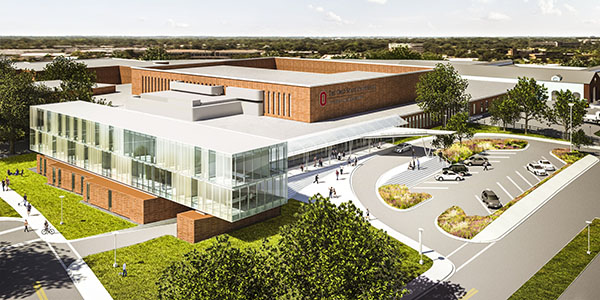
A rendering of what the hospital is expected to look like when the project is complete. Credit: Courtesy of The Ohio State University College of Veterinary Medicine.
The Ohio State Veterinary Medical Center is renovating 57,000 square feet in a four-phase enhancement and expansion project in order to improve patient care.
The construction at the OSU veterinary hospital’s existing building, located across Olentangy River at 601 Vernon L. Tharp St., has renovated its intensive-care unit, is constructing a new building for faculty offices and will revamp several other areas of the hospital, including the lobby and patient and multipurpose rooms.
“The project basically will increase our capacity to accommodate the cases that need our care, provide an improved teaching and learning experience for the clinical year of learning for the students, and also provide more optimal facilities for the actual care of the animals,” said Dr. Rustin Moore, dean of the College of Veterinary Medicine and Ruth Stanton Chair.
The project began construction in early 2015 and is set to be completed in fall 2017, Moore said.
The OSU Board of Trustees recently approved an overall budget of $32.8 million, which will be paid with development and university funds, Dan Hedman, OSU Administration and Planning spokesman, said in an email.
“It was originally about a $30 million budget, but with construction booming and costs … for labor and supplies and materials escalating, we had to get an increase to be able to deliver the project without cutting something important out of it,” Moore said.
The project’s main focus is on the Hospital for Companion Animals, which is for cats and dogs, as Moore said that about 70 percent of people in Ohio own a pet, making the project important not just for the hospital but for pet owners as well.
In the past six years, the hospital saw a 45 percent growth, starting with about 19,500 patients per year. Now the hospital serves about 27,500 patients per year, Moore said.
In addition to expanding the space in order to provide proper care for the animals, the project is looking to provide for students as well.
“We are an academic veterinary medical center, which means in addition to serving the public with advanced veterinary care, we also teach veterinary students, and we also prepare and teach residents who become specialists. So we need the space for that reason,” Moore said.
Moore said the renovations are also necessary because the faculty, staff and students have outgrown the current building.
The medical center is raising the money for the project, as it has raised about $22 million of the $32.8 million to date, said Melissa Weber, the director of communications and marketing. Because the money is being raised as the hospital remains open and running, Weber said that the project has been split into four phases.
Phase one of the project was approved in June 2014 and created the new intensive-care unit, which allows the faculty to provide care for 25-40 patients at a time through a centralized observation and workstation, Weber said. This phase also is currently constructing a new building for the hospital to use.
“(The new building) will be finished in February and will be mostly faculty and administration offices, as well as conference rooms,” Moore said. “So when that’s finished, all the faculty and staff that are in offices in the current hospital will move into that building.”
Phases two and three were approved in June 2015. Phase two will create more exam rooms to give the hospital a total of 26, instead of the former 10 with five consult rooms, and it will create a new, larger lobby, Moore said.
“Phase two, which starts March 1, is really going in where those old offices are located — which is actually in the front of the hospital — and basically demolishing all of that internally, and then creating an expansive lobby across the entire front of the building with double seating capacity,” he said.
The final phase of the project, which was approved by the Board of Trustees this November is a renovation and expansion of the “small animal surgery area” and surrounding support areas, Moore said.
This hospital houses faculty veterinarians, specialists, graduate and undergraduate students, interns and 150 to 160 staff members, including registered veterinary technicians, technologists and more. All these people are dedicated to providing the best care possible not just to dogs and cats but to all animals, such as horses, cattle, sheep and pigs, Moore said.
While many OSU students might not be very familiar with the veterinary hospital, dog owner Wyson Kong, a second-year in biochemistry, said he thinks that the renovations will benefit both the university and pet owners.
“OSU already has one of the best veterinary programs, and now that our facilities are improving, they will continue to perform at a high level,” he said. “It will be a good place for students and people in the community to bring their pets if they were to need medical assistance.”
The College of Veterinary Medicine is the largest in the U.S., in terms of students and alumni, and ranked No. 5 among all U.S. colleges of veterinary medicine, Moore said.
“We are very excited about the hospital renovation expansion, and I think it will be a great thing for the community, as well as our faculty, staff and students,” Moore said.


